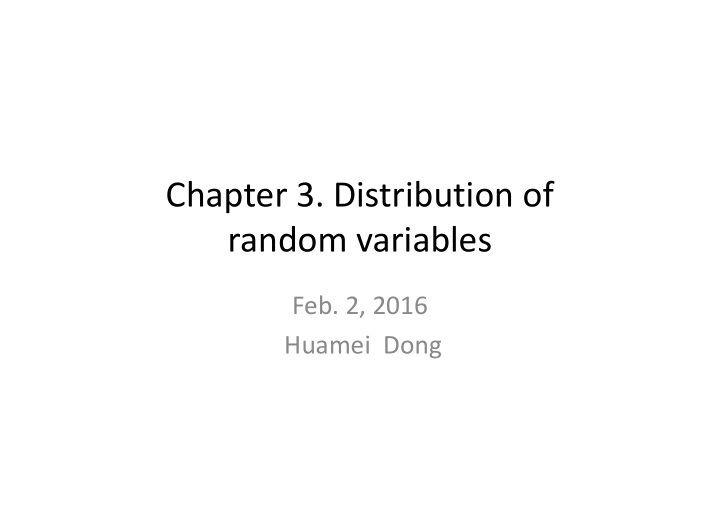



Chapter 3. Distribution of random variables Feb. 2, 2016 Huamei Dong
4. Bernoulli distribution In binomial distribution, we have (1) N total independent trials (2) Each trial can be a success or failure (3) The probability of a success p is the same for each trial The simplest the case is when the total number of trials is n=1. And the name for this distribution is Bernoulli distribution. Example 1 . If X is a random variable that takes value 1 with probability of success p and 0 with probability 1-p, then X is a Bernoulli random variable. Find the mean and Standard deviation of X. Answer: This is a discrete distribution. The probability distribution for random variable X is as the following: First Outcome Second Outcome x i 1 0 P(X= x i ) p 1-p E(X)=(1)(p)+(0)(1-p)=p
First Outcome Second Outcome x i 1 0 P(X= x i ) p 1-p ( x i -μ) 2 (1-p) 2 (0-p) 2 ( x i -μ) 2 p(X= x i ) (1-p) 2 p (0-p) 2 (1-p) Var(X) =(1-p) 2 p+(0-p) 2 (1-p)=(1-p) 2 p+p 2 (1-p)=p(1-p) σ(x)=
5. Geometric distribution Example 2. If we roll a fair die, what is the probability that the first time we get the “1” is the sixth time when we roll it? Answer: The probability of getting the first “1” on the sixth roll is the probability of Not getting “1” during the first five rolls and getting “1” on the sixth roll . So P(getting the first “1” on the sixth roll)= =0.067 Geometric distribution: If the probability of a success in one trial is P and the probability of a failure is 1-p, then the probability of finding the first success in the nth trial is given by (1-p) n-1 p The mean , variance, and standard deviation of this wait time are
6. Negative Binomial Example 3. If we roll a fair die, what is the probability that we get the third “1” when we roll the die the sixth time? Answer: If we get the third “1” on the sixth time, we have to get two “1”s during the Previous five rolls. So the probability of getting the third “1” on the sixth roll is the Probability of “ getting two ‘1’s during the first five rolls” and “ getting ‘1’ on the sixth roll” . P(getting the third “1” on the sixth roll) =P(getting two “1”s during the first five rolls)x P(getting “1” on the sixth roll) Here P( getting two “1”s during the first five rolls ) is just the binomial distribution. So P(getting two “1”s during the first five rolls)= P(getting “1” on the sixth roll)= So the P(getting the third “1”on the sixth roll)=
Negative binomial distribution The negative binomial distribution describes the probability of observing the kth success on the nth trial: P( the kth success on the nth trial)= Comments on binomial versus negative binomial (1) Binomial : We have fixed number of independent trial and look for the probability of number of successes The P( Exactly k successes in n trials)= (2) Negative binomial: We have fixed number of successes and look for the probability of the number of trials it takes. The P(the kth success on the nth trial)=
Example 4. If a high school football player Brian makes each 35 yard field goal with probability p=0.8. Prove that the probability Brian kicks fourth successful field goal on the sixth attempt is 0.164. Answer: This is negative binomial model. P(kicking fourth successful field goal on the sixth attempt) =P(kicking 3 successful field goals in the first 5 attempts) x P( kicking a successful field goal on the sixth attempt) = Chapter 3 Homework#5 (due 02/09/16): Page 166 . 3.39. 3.40
Recommend
More recommend